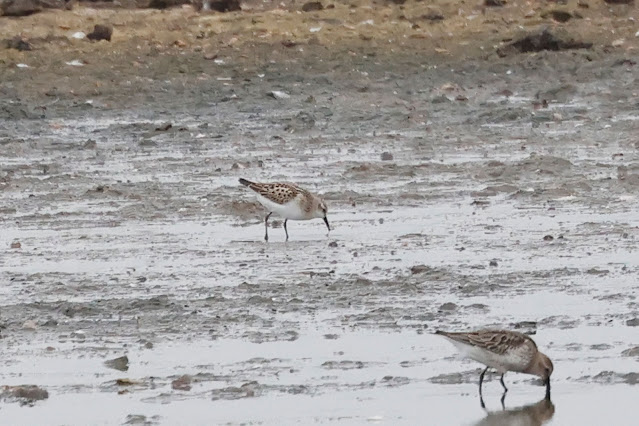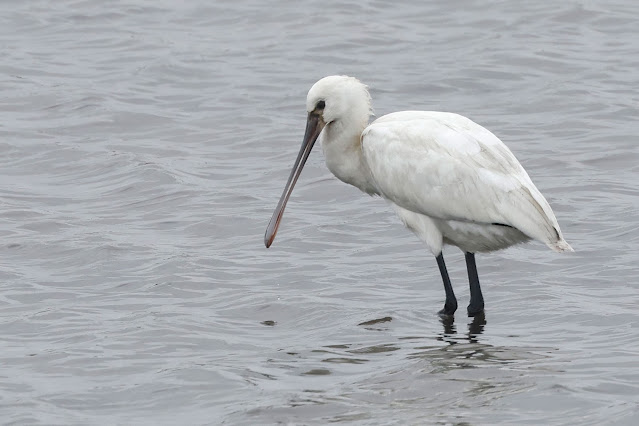For the first time in a long time I decided to head west and down to the coast at Keyhaven, not my normal early start and I paid for that with a full car park. I managed to find a space on the bend of Lower Pennington Lane.
From the car park I followed the west side of the old tip towards Fishtail, the tide was high and there were good numbers of waders at the back of the lagoon, plus two Spoonbill that seem to have become almost resident. Rather than scan from the tip I decided to make my way to the sea wall where I would be a little closer.
The majority of the waders were Dunlin and Ringed Plover but there were a few gems in amongst them. At the back of the shallow pool was a Little Stint, unfortunately a record shot.
There were at least nine Knot roosting with Redshank.
One Ruff, looks like a male.
A Common Gull, always one of my favourites.
There were three Curlew Sandpipers feeding amongst the Dunlin.
This one definitely an adult as it shows remnants of the brick red summer plumage.
And finally a single Common Sandpiper.
From Fishtail I turned to the east and headed towards Butts Bay, offshore there were two Eider, both moulting, but one quite close to the shore.
Moving on to the Jetty Lagoon I found another Curlew Sandpiper in amongst a small group of Dunlin, that themselves were feeding around a large group of Black-tailed Godwits.
The Spoonbill that had been on Fishtail when I arrived were now feeding on the Jetty Lagoon.
Both are immature birds, lacking the colour in the bill and when in flight they show the black tips to the primaries.
Suddenly one decided it want to leave and took off, showing clearly the black primary tips.
And was then joined by the other and they both flew back to Fishtail.
I walked on towards Pennington Marsh, stopping at the Jetty where there was a single Wheatear.
And the usual high tide Turnstone roost.
Around the edge of the lagoon were two small waders, getting closer I realised these were Curlew Sandpipers, feeding on the mud and around the water edge. For once they were quite close and I was able to get some great views and some nice shots.
Nice to have two close together.
These are juvenile birds showing the scaly rufous upper parts with the pale fringes and the peachy wash on the breast and belly.
What is striking for me is the supercilium, you know they have one but when you see it is quite striking.
Eventually pulling myself away from the Curlew Sands I continued east. At Oxey Marsh there was a large raft of Eider offshore, I counted 34.
A Greenshank was roosting on Oxey Marsh.
While this Redshank stood out for me, standing on a rock and contrasting against the vegetation in the background.
The tide was very high and there was little else as I made my way to Normandy other than a pair of wild swimmers. As I turned towards Normandy I noticed a chat on top of a bush, Identified it as a Whinchat and as I tried to get close it was flushed by a dog walker, despite my pleas to wait.
On the shallow lagoon at Normandy was yet another Curlew Sandpiper amongst the Dunlin and Redshank and Turnstone around the edge. I noticed a flock of Grey Plover on the south side so headed there for closer views, on the bend I came across a Wheatear that allowed me to get very close.
It then flew to the bench before heading off across the lake.
The Grey Plover showed very well a few still having the majority of their stunning silver and black summer plumage.
A stand out here at Normandy was the sheer number of Ringed Plover roosting on the islands in the lagoon. I estimated it as around 700 birds and every so often they would fly around as if spooked by something, or just wanting to test if the tide was falling.
I walked back to Pennington across the fields with little of interest. Crossing the old tip on the east side the cattle were close to the path and in amongst them were three Cattle Egret. They were distant but this presented the opportunity for some classic Cattle Egret scenes.
Walking to the car in Lower Pennington Lane I came across two huge Hornets hunting bees around the ivy, whilst large I can assure they were not the Asian Hornets the media are so wrapped up with.
After lunch and a car move it was back to Fishtail where most of the waders had gone, but the Spoonbill were back and feeding.
They had worked their way to the east side of the lagoon and were suddenly spooked by a birder coming down on to the path.
There was only one Avocet all day and this appeared to be happy to stay on Fishtail. From the brownish plumage it is probably one of this year's offspring.
If there are to be any waders on Fishtail they usually like the far west corner where the water is shallow. I made my way there and my hunch was right, there were four Black-tailed Godwits chattering away to each other and two Ruff and and a Curlew Sandpiper.
The ruff were male and female and you can see the size difference here, the male being the larger for once.
The light was very good and the shallow water produced some lovely reflections.
The male
Female
As the Ruff walked away behind the reeds I concentrated on the Curlew Sandpiper, once again a juvenile bird.
In the company of Dunlin the Curlew Sandpiper then disappeared behind the reeds. I very white Pied Wagtail in front of me turned out to actually be the nominate species known as the White Wagtail, Pied Wagtail is actually the sub species
The white wagtail has a pale grey back and there is a very clear demarcation between the black of the neck and nape with the much paler grey back.
The Ruff and Curlew Sandpiper eventually came back, here a Dunlin.
It was time to go, a quick check of the marsh revealed a Peregrine sat on a post, but very distant and with the heat haze impossible to photograph.
It had been a good day with some great opportunities.















































































No comments:
Post a Comment